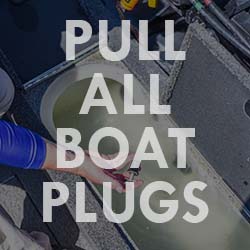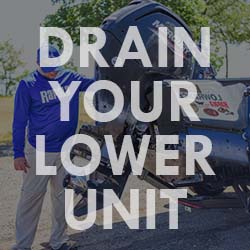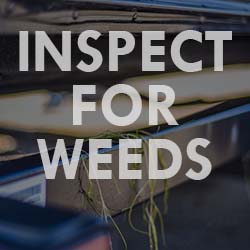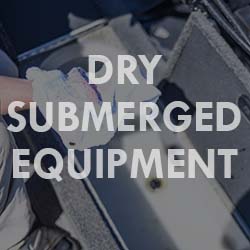resources and frequently asked questions
Clean. Drain. Dry




Never move water when transporting your bait and/or fish.
Inspections are easy and if you see a station you need to do your part.
Learn More About How You Can Clean, Drain, Dry
Frequently Asked Questions
How are AIS being managed?
The Department of Game, Fish and Parks has developed an AIS Management Plan to direct AIS management in South Dakota.
Where did they come from/how did they get here?
Some of these AIS likely “hitchhiked” to South Dakota on boats, construction equipment and by downstream/upstream migration on large rivers. Others, like zebra mussels, were inadvertently brought to the United States in cargo ship ballast water or in the case of invasive carp were imported, escaped captivity and then “hitched a ride” to South Dakota.
How can we get rid of them?
If an introduction into a new waterbody is found early, chemical and physical removal may be possible. Often the species isn’t discovered in a water body until the population is reproducing in large numbers. At this point complete eradication efforts are likely not possible.
What is the State of South Dakota doing to help?
The state’s AIS program has evolved over the years, as new species have been detected and have spread to new waters. The current approach to AIS management in South Dakota includes:
- Using AIS inspection stations on roadways or at boat ramps to actively engage boaters and show them how to clean, drain, and dry their specific watercraft, so they can help slow the spread of AIS to new waters.
- Annually conducting education and outreach campaigns to inform boaters and members of the public of AIS species present, how they impact water users, and how to reduce their spread to new waters.
- Enforcing AIS laws and regulations requiring watercraft to be clean, drained, and dried upon leaving a water.
- Establishing partnerships with groups and individuals to monitor for AIS and encourage boaters to clean, drain, and dry their watercraft after each use.
What can I do to help?
Anglers and recreational boaters are the first line of defense in the fight against AIS.
Anytime you believe you have found a new AIS introduction, please notify GFP immediately. Every boat operator should inspect their boat for attached mud, vegetation or animals, drain all water from the boat and motor, and dry all compartments before and after each launch. When possible, operators should powerwash their boat and allow it to dry between trips.
Are these species spread by ducks, geese and other animals?
Although waterfowl often visit multiple waters in a day, it is very unlikely that animals move AIS to new waters. Waterfowl are not found in high densities in South Dakota during most of the zebra and quagga mussel spawning season when veligers are abundant, and most animals are too mobile for adults to attach.
When do I need to have the drain plug opened or removed from my boat?
Boaters and anglers are required to open or remove all drain plugs or similar devices; except when in the boat ramp parking lot area or when the boat is being launched or loaded. A boat may have these devices closed or in place while in route to a fish cleaning station that is within the boat ramp parking lots area, but they must be opened or removed before leaving the fish cleaning station.
- What this means: Plugs have to be pulled when a boat is not on the water. Boaters and anglers may keep fish or bait in a livewell while transporting the boat from the water body to a fish cleaning station, only if the fish cleaning station is located within the boat ramp parking lot area and they must pull the plugs before they leave the cleaning station. If there is no cleaning station within the boat ramp parking lot area, then the plugs need to be pulled before leaving the boat ramp parking lot.
Can I replace my plug after I drain all of the water from my boat?
No, the regulations require all plugs to be opened or removed while the boat is not on the water. This allows water to drain from a boat and aides in drying out damp compartments.
When can I put my boat plugs back in?
Plugs may be replaced when preparing your boat for launch in the boat ramp area. Plugs cannot be replaced at a campsite or cabin prior to arrival at the boat ramp area.
Do I still need to remove my drain and livewell plugs even though I only fish or boat at one lake and never take my boat or watercraft anywhere else?
Yes, all plugs on a boat need to be opened or removed any time the boat is being transported over land. This ensures that little or no water is taken away from a water body.
Do these regulation apply to ski/wakeboard boats, sailboats or other pleasure boats?
Yes, all plugs need to be opened or removed when any type of boat is not on the water. Any water moved from one waterbody to another may be holding invasive invertebrates or plants.
What do I need to know about transporting my bait and/or fish?
Bait and fish may not be transported in water taken from a lake, river or stream except while en route to a fish cleaning station that is located within the boat ramp parking area, but must be drained prior to leaving the fish cleaning station.
- What this means: If anglers wish to transport their aquatic bait and fish in water, they can only be transported in domestic water (tap water, well water, bottled water, ice). Most domestic water must be treated to remove chlorine prior to putting fish in it. However, when leaving a water body, boaters and shore anglers can wait until they reach a fish cleaning station to put their bait in domestic water as long as that fish cleaning station is located within the boat ramp parking area.
How do I dechlorinate domestic water to keep my bait alive?
Many pet shops, department stores and some online retailers sell products to remove chlorine from aquarium water and water in fish ponds. Add these products to domestic water prior to placing your bait in the water.
Can I fill my livewell with ice to transport my harvested fish?
Yes, but only if the livewell plug has been pulled and remains open during transport.
How should I transport my fish if I want to clean them at home or if there is not a fish cleaning station next to where I am fishing?
Anglers have three options for transporting whole fish for cleaning at home or at a cleaning station that is not located within the boat ramp parking area.
- In a container (not a part of the boat), that is filled with domestic water (tap water, well water, bottled water, ice).
- On ice - in a cooler or pull the plug on their livewell and fill it with ice (plug must remain out).
- Dry - put fish in an empty bucket or pull the livewell plug before leaving the boat ramp and let it drain when traveling.
Can I take my minnows home after fishing?
Bait can only be transported away from a water body in domestic water (tap water, well water, bottled water, ice). Boat anglers can wait until they reach a fish cleaning station to put their bait in domestic water only if the fish cleaning station is located within the boat ramp parking area. They can dump out the lake water and fill their bait bucket up with water from the cleaning station or water they brought with them.
A shore angler can do the same if they are able to access the domestic water source at a fish cleaning station that is located within a boat ramp parking area or if they bring domestic water with them.
Minnows may be used in multiple lakes as long as they are transported between lakes in domestic water. Lake water must be drained before leaving each lake.
Most domestic water must be treated to remove chlorine prior to putting fish in it.
I’m camping at the campground right next to the lake. If I want to keep my bait at my campsite overnight to use at the same lake tomorrow, do I still need to drain the lake water and use domestic water?
Yes, bait cannot be transported away from a waterbody in water obtained from a lake, river or stream.
If you wish to take your bait away from the water for later use, you will need to utilize a domestic water source.
Most domestic water must be treated to remove chlorine prior to putting fish in it.
Where should I dispose of my unused minnows?
Unused minnows should be poured into the fish grinder at a cleaning station or drained and disposed of in the trash containers at the boat launch or cleaning areas. It is a violation of state statute to dump unused minnows into a water body.
What if there is not a fish cleaning station available?
If there is not a cleaning station at the site where anglers are fishing, drain plugs must be opened and bait containers must be free of lake water before leaving the boat launch area.
Can I harvest Silver, Bighead, Grass or Common Carp?
Anglers may harvest any fish or crayfish species that are considered an aquatic invasive species provided they are transported dead (cleaned, gutted or on ice). Unlike Common Carp, Silver and Bighead Carp are filter feeders and have firm, white flesh that is very similar to Walleye. This video will show you how to easily clean, cook and eat Invasive carp wings.
Can I shoot jumping invasive carp with a firearm?
Invasive carp anglers/hunters may not shoot at jumping invasive carp with a firearm. If you are interested in shooting jumping invasive carp, the season is open year-round for bow and spear anglers.
Can I capture my own baitfish?
Licensed anglers may collect their own bait with legal equipment in many areas of South Dakota. To prevent the spread of invasive carp, the Missouri River below Gavins Point Dam and all flowing waters (creeks, streams or rivers) in most counties in the James, Vermillion and Big Sioux watersheds are closed to the taking of bait. For more information, please refer to the South Dakota Fishing Handbook.
More Information
South Dakota is not alone in working to slow the spread of AIS. Many state, federal, tribal and non-governmental agencies work diligently to address this issue across the United States. Additional information on these efforts and more detailed species information can be obtained by contacting the South Dakota Game, Fish and Parks or checking out the resources below.
- Aquatic Invasive Species in South Dakota and Watercraft Inspection and Decontamination
- AIS Laws and Regulations in South Dakota
- USGS Nonindigenous Aquatic Species
- National Invasive Species Information Center
- Aquatic Nuisance Species (ANS) Task Force



